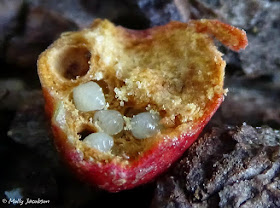
Mark Bower sent me this picture of a "weird thing" he found while out photographing mushrooms. He described it as being hard and growing off of a plant. Now when a man whose passion is photographing fungi thinks something he found is "weird" I have to take it seriously. To me it appeared to be a deformed part of a plant stem, likely a gall.
 |
| Gall in winter - Joshfecteau.com |
 |
| H. nubilipennis - John van der Linden |
 |
| Wasp larvae in the gall - Molly Jacobson |
Galls are a major problem among blueberry growers and the primary treatment is pruning of parasitized stems. Elimination of the wasps takes persistence over years. Although blueberries are self-pollinating, cross pollination by insects produces larger fruit. Spraying insecticide as a secondary treatment against the wasp is tricky as the wasps emerge in blooming season at the same time as honeybee pollination. Michigan State
 |
| Wasp emerging from a Blueberry Stem Gall - Nature Posts |
"Eupelmus vesicularis (Eupelmidae) has also been reared from these galls, and by contrast is one of the least host-specific chalcidoids–its known hosts include six different orders of insects. It is thought to have been introduced from Europe in straw, and the list of host species in North America is said to be “tiresomely long.”
So of my gall emergences so far this year, one in four has been the actual gall inducer, and the rest have been parasitoid wasps. I think this is pretty representative of what’s going on out there–there seem to be more parasitoids than anything else. Hemadas nubilipennis galls are multi-celled, so it will be interesting to see what else comes out of the ones I collected." - Charley EisemanWe haven't identified many blueberry plants in our valley and I wonder how the wasp found a victim. We will start looking more carefully for other plants. Details on the lowbush blueberry are at llinoiswildflowers.info. For an interesting history of the blueberry stem gall read pages 14-17 of this 1981 Ospry newsletter.
=======
Some of the findings from MN Wildflower Walk I are at this link. WW II (not the war) is on April 14th at 1PM.